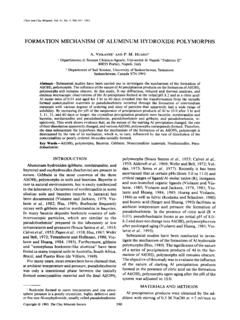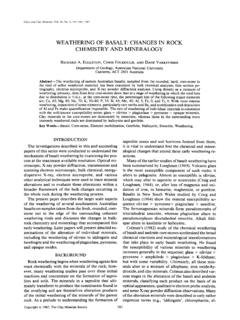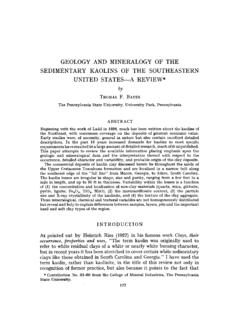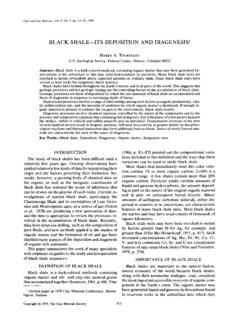Transcription of THE ORIENTATION AND INTERACTION OF …
1 Clays and Clay Minerals, Vol, 25, pp. I13-118. Pergamon Press 1977, Printed in Great Britain THE O R I E N T A T I O N A N D INTERACTION OF. E T H Y L E N E D I A M I N E COPPER (II). WITH M O N T M O R I L L O N I T E. JOHN L. BURBA III and JAMESL. McATEE, JR. Chemistry Department, Baylor University, Waco, TX 76703, (Received 28 May 1976; and in final form 16 October 1976). Abstract The d(001) spacings for a series of montmorillonite samples containing increasing amounts of Cu(eu)] + were recorded after exposure to 50% humidity, 10% humidity, and air that had been saturated with ethylene glycol. It was found that Cu(en)~+ is too large to fit between the montmoril- lonite particles and that in those samples with large amounts of ethylenediamine Cu(II) added, the clay platelets are associated with stronger interactions than those with small amounts of Cu(II) complex added.
2 Infrared spectroscopy and electron spin resonance analysis indicate that the absorbed copper (II). complex is the square planar bis ethylenediamine Cu(II) and that the complex ion is oriented so that the dz~ orbital is perpendicular to the clay surface. The montmorillonite particles may act as ligands and coordinate with Cu(en)~+ ions. INTRODUCTION. morillonite was prepared by the addition of an excess Recently there has been an interest in the study of amount of Cu(II) chloride solution. The clay was coordination compounds sorbed to clay minerals, washed by successive centrifugation until addition of (Theng, 1974; Clementz, 1973; McBride, 1974; ammonia to the wash water did not produce a blue McBride, 1975; Rupert, 1973; and Thielmann, 1975).
3 Solution. Ammonia was added to 25 ml of the Cu(II). Thielmann examined the feasibility of using com- montmorillonite, and the excess was removed by suc- plexes of various tris ethylenediamine metal ions With cessive washings. Another sample was prepared first montmorillonite as gas chromatography columns for by reacting a solution of Cu(II) chloride with the separation of light hydrocarbons. Tris ethylenedia- ammonia then the solution was reacted with Na . mine copper(II) montmorillonite was one of the com- montmorillonite and the clay was washed until a plexes that was examined. Because of its rather extra- negative AgC1 test was obtained. ordinary properties, such as the ability to form stable Dispersions containing 0, 10, 20, 50, 75, 100, and gels with relatively small amounts of montmorillonite, 120mequiv.
4 Of Cu(en) 2+ added/100g of clay were further examination was of interest. used in the X-ray experiments. Three samples were This paper deals with results obtained from X-ray taken from each dispersion and dried on petrographic powder diffraction, Fourier synthesis and transform microscope slides. calculations, infrared spectroscopy, and electron spin A series of experiments was carried out in which resonance analysis of the tris ethylenediamine cop- the samples were placed in a desiccator for 48 hr at per(II) montmorillonite system. room temperature and X-rayed. Three desiccators were used in the following order; saturated calcium nitrate, which has a relative humidity of 51G; dried EXPERIMENTAL TECHNIQUES calcium chloride, 10% relative humidity; and ethylene glycol.
5 A dispersion of Na + montmorillonite containing The ! 00 mequiv. Cu(en) 2+/100 g of montmorillonite clay by weight was prepared from spray-dried samples were left in the ethylene glycol desiccator for 100% Na + exchanged Wyoming Bentonite. From this 30 days. The samples were X-rayed and compared suspension and a solution of Cu(en)3SO4, to X-ray patterns of Cu(II) montmorillonite and the samples containing 0, 10, 20, 40, 50, 75, 100, and two Cu(II) ammonia clay complexes, each of which 120 mequiv. Cu(en)~ +/100 g of clay were prepared by were exposed to ethylene glycol for 48 hr. pipetting various amounts of the complex ion into The infrared analysis utilized samples containing a known volume of the clay dispersion.
6 The total 0, 40, and 100mequiv. Cu(en)2+/100g of clay. volume of each sample was adjusted to 250 ml and Oriented films of these clays were made by drying the clay was transferred to polyethylene bottles. Each portions of the clays on petrographic microscope dispersion was then dispersed with an ultrasonic cell slides. Slivers were peeled from the slides and placed disrupter. The per cent clay by weight of each sample in supports which held them firmly in place. Spectra was 1%. were then recorded of these samples for comparison A 1% dispersion of 100% exchanged Cu(II) mont- purposes. 1t3. 114 JOHN L. BURBAIII and JAMESL. MCATEE,JR. The ORIENTATION studies were carried out on samples of 40mequiv.
7 Cu(en)~+/100g of clay which were washed by centrifugation until a negative AgC1 test was obtained. This clay was used rather than the 100 mequiv. Cu(en)32+/100 g of clay sample because the 100 mequiv. Cu(en)~+/100g of clay flocculated to such an extent that the films made from it did not 15-- make uniformly thick samples. o . _ o _ _ c .. ~ --'~. The samples containing 40 mequiv. Cu(en)32+/100 g of clay were heated at 108~ for 8 hr and cooled in a desiccator containing calcium chloride. Two in- frared spectra were then recorded in which the angles of ORIENTATION between the clay film and the infrared beam were 90 and 40%. A 1~ dispersion of montmorillonite, which was II-- 100~o exchanged with Cu(en)32+ and then washed to remove any ions that were not adsorbed, was pre- pared as a self-supporting film.
8 This was then I P I I I I. 0 20 40 60 eo ioo 120. mounted on a flat fused silica ORIENTATION device for Meq. of Cu(EN)~ 2 odded electron spin resonance. Figure 1. Plot of d(001) spacing vs the amount of ethylene- Spectra were recorded with the film oriented per- diamine Cu(II) added for samples at 51~ humidity. pendicular and parallel to the flux of the magnetic field. thickness of Cu(en) 2+, obtained from Fisher models, DISCUSSION is about 4A. The calculated d(001) spacing for Cu(en)~ + montmorillonite can then be either General observations if the thickness of Cu(en) 2+ is considered to be 3 A, Addition of Cu(en)~SO4 solution to Na + montmor- or A if a thickness of 4 A is used. If the thickness illonite causes immediate flocculation of the clay.
9 Of Cu(en) z is slightly greater than 3A, Cu(en)~ . Even in dispersions containing small amounts, ~ could still yield a d(001) spacing of ]~ if the clay by weight, aggregates form readily. The aggre- complex is able to key into hexagonal holes in the gates will break apart when the dispersions are agi- surface of the clay or if the bonding between the metal tated with an ultrasonic cell disrupter, but after treat- complex and the clay causes a shortening of the bond ment they reform. The addition of Cu(en)~ + also distances. causes the color of montmorillonite to change from Figure 1 is a plot of d(001) vs the amount of ethy- tan for Na + montmorillonite, to pink for montmoril- lene-diamine Cu(II) that was added to the clay.
10 This lonite with Cu(en) 2 + added. plot pertains to clay at 50% humidity. As the ethy- Na* montmorillonite has a pH of about 7. Addi- lenediamine Cu(II) is added there seems to be little tion of 100 mequiv. Cu(en) 2 +/100 g of clay causes the change in the d(001) spacing. pH of montmorillonite to change to about thirteen. Figure 2 is a plot of Warren's constant, which is This change in pH is due to the dissociation of a measure of uniform stacking in clay (Brown, 1961). Cu(en)32+ to Cu(en)2z+ in water solution (Huheey, vs the amount of ethylenediamine Cu(II) added. The 1972). Thus, the ion in solution is Cu(en) 2+ rather than Cu(en)~ +, X-ra), powder diffraction analysis o The thickness of Cu(en)~ + is about 6A, as measured by Fisher-Hirschfelder-Taylor Metal-Coor- dination models, and the thickness of a clay platelet is A (Grim, 1968).










